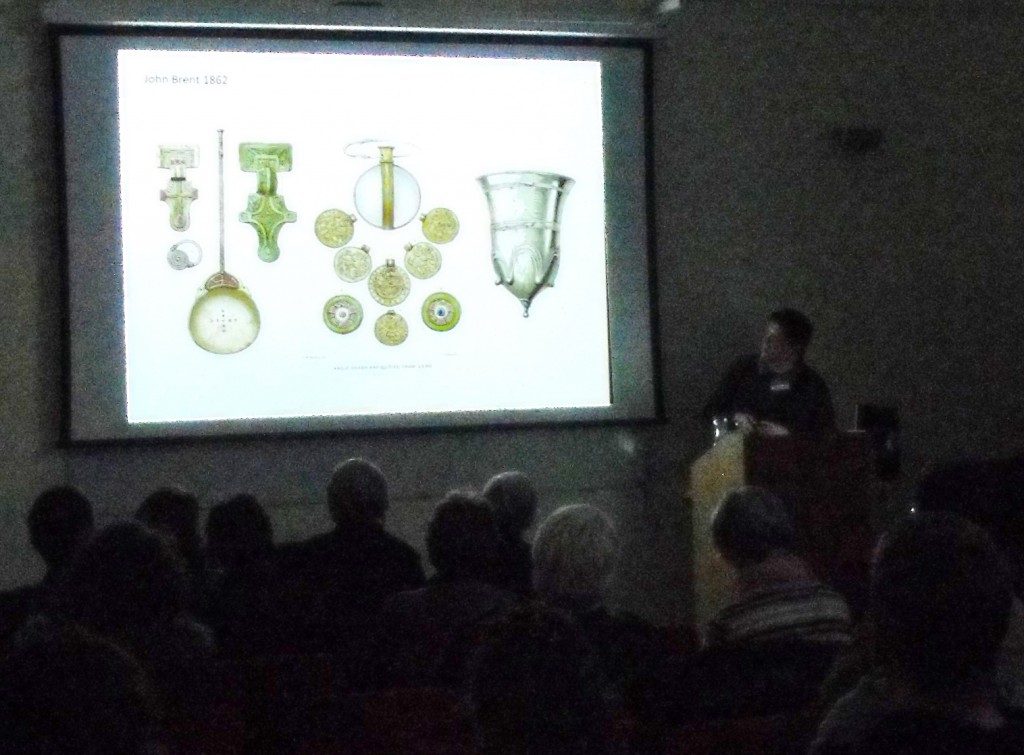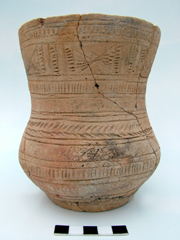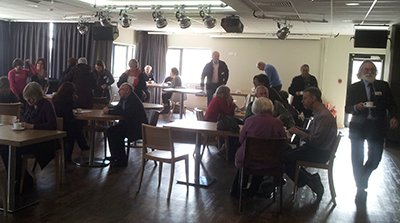 Celebrations for the Trusts 25th Anniversary continued on Saturday 27th of April 2013 with a day conference titled Exploring our Past – Preserving our Heritage, also held at the Broadstairs campus of Canterbury Christchurch University.
Celebrations for the Trusts 25th Anniversary continued on Saturday 27th of April 2013 with a day conference titled Exploring our Past – Preserving our Heritage, also held at the Broadstairs campus of Canterbury Christchurch University.
Six talks were given about aspects of the exploration and preservation of Thanet’s heritage on the themes of Landscape, Townscape and ‘Peoplescape’.
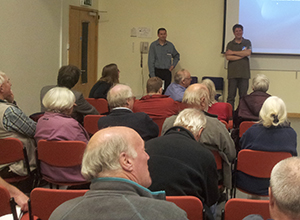 Once the congregation of archaeological and heritage minded people attending the conference finished their welcoming teas and coffees at the Touchdown Bar, they swiftly moved to the large lecture theatre for the start of the conference at 9.45 am. The Chairman of the Trust for Thanet Archaeology, Simon Perry, gave a welcoming speech and introduced the first talk, given by Rod LeGear.
Once the congregation of archaeological and heritage minded people attending the conference finished their welcoming teas and coffees at the Touchdown Bar, they swiftly moved to the large lecture theatre for the start of the conference at 9.45 am. The Chairman of the Trust for Thanet Archaeology, Simon Perry, gave a welcoming speech and introduced the first talk, given by Rod LeGear.
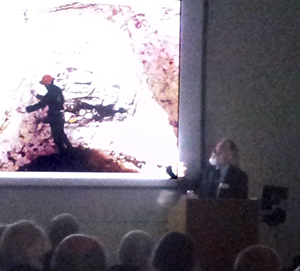 Rod, a retired mining engineer and a founding member of the Kent Underground Research Group, explained how Thanet’s chalk geology has been exploited in the past by local industry and agriculture. Raw chalk, taken from underground sources ranging from shallow pits to more extensive mines where thousands of tons were produced, was used as a fertiliser and burnt to produce lime for agriculture and to make bricks for the thriving building industry which created Thanet’s sea side suburbs. Many of these pits and mines have been put to other uses and remain visible in Thanet’s landscape with careful observation and historical research. Rod’s presentation drew attention to these industries as valid parts of our heritage and records of lives and labour of many people.
Rod, a retired mining engineer and a founding member of the Kent Underground Research Group, explained how Thanet’s chalk geology has been exploited in the past by local industry and agriculture. Raw chalk, taken from underground sources ranging from shallow pits to more extensive mines where thousands of tons were produced, was used as a fertiliser and burnt to produce lime for agriculture and to make bricks for the thriving building industry which created Thanet’s sea side suburbs. Many of these pits and mines have been put to other uses and remain visible in Thanet’s landscape with careful observation and historical research. Rod’s presentation drew attention to these industries as valid parts of our heritage and records of lives and labour of many people.
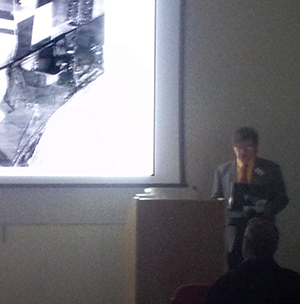 Dr. Mark Samuel, an architectural archaeologist based in Ramsgate, followed Rod with a talk on a survey that explored the remains of defensive structures that were built to protect the Pegwell Bay area under the threat of German invasion during the early years of the Second World War. Images were shown of the remains of many of the defences that can still be seen in the landscape today with careful observation and a relatively modest amount of field work. Mark explained how the defences were expected to be used in the event of a German invasion and presented some of his ideas about how the importance of the south coast of Thanet and Pegwell Bay might have been perceived during the Second World War, perhaps explaining why many of the sites he surveyed had been lost to history until his survey and research uncovered this secret landscape.
Dr. Mark Samuel, an architectural archaeologist based in Ramsgate, followed Rod with a talk on a survey that explored the remains of defensive structures that were built to protect the Pegwell Bay area under the threat of German invasion during the early years of the Second World War. Images were shown of the remains of many of the defences that can still be seen in the landscape today with careful observation and a relatively modest amount of field work. Mark explained how the defences were expected to be used in the event of a German invasion and presented some of his ideas about how the importance of the south coast of Thanet and Pegwell Bay might have been perceived during the Second World War, perhaps explaining why many of the sites he surveyed had been lost to history until his survey and research uncovered this secret landscape.
After a brief break at the Touchdown Bar for more tea, coffee and biscuits, everyone regrouped in the lecture hall for a talk by Emma Boast the Director of the Trust for Thanet Archaeology.
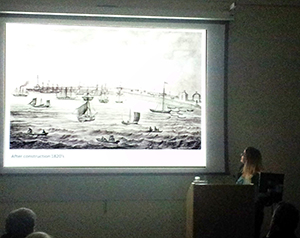 Emma gave a presentation on the history and importance of Margate Pier, beginning by discussing how the research for the talk was produced for a survey of the pier carried out by the Trust in 2005, in the planning stages for the original design of the Turner Contemporary. A history of the pier was given, beginning with its construction in 1810 and Emma explained how the pier has had a variety of uses for leisure and industry since its construction. Many people were intrigued by the miniature railway which once ran along the harbour wall, prompting much discussion after the talk and later in the lunch break. Emma finished by mentioning some of the changes that have occurred to the fabric of the pier that have left visible traces connected to the development of the town, making the pier a key element of Margate’s historic townscape which records the changing emphasis of the lives and industries that have made Margate thrive in the past.
Emma gave a presentation on the history and importance of Margate Pier, beginning by discussing how the research for the talk was produced for a survey of the pier carried out by the Trust in 2005, in the planning stages for the original design of the Turner Contemporary. A history of the pier was given, beginning with its construction in 1810 and Emma explained how the pier has had a variety of uses for leisure and industry since its construction. Many people were intrigued by the miniature railway which once ran along the harbour wall, prompting much discussion after the talk and later in the lunch break. Emma finished by mentioning some of the changes that have occurred to the fabric of the pier that have left visible traces connected to the development of the town, making the pier a key element of Margate’s historic townscape which records the changing emphasis of the lives and industries that have made Margate thrive in the past.
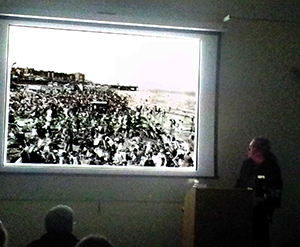 The final speaker of the morning session was Nick Dermott, Conservation Officer for Thanet District Council, who talked about how, as pioneers of mass entertainment, Thanet’s historic townscapes were shaped by the early growth of the leisure industry. Beginning by looking at the history of pleasure gardens and the remarkable survival of one example at Ranelagh Grove at St Peters, Nick went on to talk about the history of Margate as an archetype of the seaside town where beach holidays originated. Nick spoke about the popularity of sea bathing in Margate and even the contemporary issues surrounding the development of mixed and even naked bathing. Keeping to the beaches, other forms of entertainment were touched on, such as the popular Donkey rides on the beach and Punch and Judy shows. Nick also looked at other forms of entertainment from Margate’s past away from the beach; the theatres, music halls, cinemas, Winter Gardens, West Cliff Hall and the importance to Margate of the development of Dreamland. The presentation was richly illustrated with wonderful and rare photographs, posters and books which reflected the rich diversity of Thanet as a tourist destination in the past present and future.
The final speaker of the morning session was Nick Dermott, Conservation Officer for Thanet District Council, who talked about how, as pioneers of mass entertainment, Thanet’s historic townscapes were shaped by the early growth of the leisure industry. Beginning by looking at the history of pleasure gardens and the remarkable survival of one example at Ranelagh Grove at St Peters, Nick went on to talk about the history of Margate as an archetype of the seaside town where beach holidays originated. Nick spoke about the popularity of sea bathing in Margate and even the contemporary issues surrounding the development of mixed and even naked bathing. Keeping to the beaches, other forms of entertainment were touched on, such as the popular Donkey rides on the beach and Punch and Judy shows. Nick also looked at other forms of entertainment from Margate’s past away from the beach; the theatres, music halls, cinemas, Winter Gardens, West Cliff Hall and the importance to Margate of the development of Dreamland. The presentation was richly illustrated with wonderful and rare photographs, posters and books which reflected the rich diversity of Thanet as a tourist destination in the past present and future.
A break for an hour for lunch gave a chance for attendees to view display tables set up in the foyer of the University building. Two displays were presented by the Trust; one with local finds including hand axes and pottery, the other included a Roman soldier’s costume which the Trust produced for their education activities, along with a copy of a book the Trust is publishing which shows how to make the armour and fittings as a craft project. Another display publicised the Isle of Thanet Archaeological Society and gave visitors the opportunity to join their organisation. David Crawford-White, one of the afternoon speakers gave information on some of the community archaeology projects he has managed and advice on how to apply for heritage lottery funding.
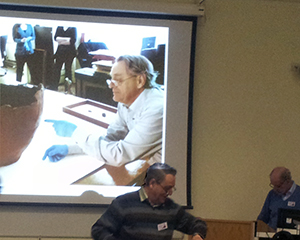 The first presentation in the afternoon session after lunch, was given by Bob Pantony, a long standing member of the Isle of Thanet Archaeological Society. Ably assisted in his slide show by Mr. Bob Varnham, Bob Pantony spoke of the contribution of Doctor Arthur Rowe of Margate, and his father before him, to the study of the Geology and Archaeology of Thanet in the early 20th century. Dr. Rowe’s private archaeological collection was bequeathed to the people of Margate and included finds from his own excavations as well as discoveries made during the expansion of Thanet’s towns, along with material his father, Dr. Thomas Smith Rowe, had collected. The senior Dr. Rowe was firmly established as an early archaeologist in Thanet who contributed a great deal to the collection that his son left to the people of Margate and Bob had even traced an interesting line drawn portrait of him from a local newspaper. Images were shown of many of the items that were formerly in the collection, some of which are now held by the British Museum. Attention was drawn to the poor state of preservation of much of the Rowe bequest material in other collections which has not been properly conserved. It was evident from Bob’s efforts to trace the items from the Rowe Bequest that Arthur Rowe was a pioneer of intellectual enquiry into Thanet’s past, an important element of Thanet’s historic ‘peoplescape’.
The first presentation in the afternoon session after lunch, was given by Bob Pantony, a long standing member of the Isle of Thanet Archaeological Society. Ably assisted in his slide show by Mr. Bob Varnham, Bob Pantony spoke of the contribution of Doctor Arthur Rowe of Margate, and his father before him, to the study of the Geology and Archaeology of Thanet in the early 20th century. Dr. Rowe’s private archaeological collection was bequeathed to the people of Margate and included finds from his own excavations as well as discoveries made during the expansion of Thanet’s towns, along with material his father, Dr. Thomas Smith Rowe, had collected. The senior Dr. Rowe was firmly established as an early archaeologist in Thanet who contributed a great deal to the collection that his son left to the people of Margate and Bob had even traced an interesting line drawn portrait of him from a local newspaper. Images were shown of many of the items that were formerly in the collection, some of which are now held by the British Museum. Attention was drawn to the poor state of preservation of much of the Rowe bequest material in other collections which has not been properly conserved. It was evident from Bob’s efforts to trace the items from the Rowe Bequest that Arthur Rowe was a pioneer of intellectual enquiry into Thanet’s past, an important element of Thanet’s historic ‘peoplescape’.
David Crawford-White gave the last talk of the day on the community aspects of the recent archaeology project associated with the East Kent Access road scheme and on the potential for securing Heritage Lottery funding for archaeological projects. David is the Outreach and Learning Officer for Oxford Archaeology East based in Cambridgeshire and ran the outreach programme in Thanet for East Kent Access. In the first part of the talk David spoke about the community aspects of the East Kent Access road scheme archaeology project, considering which community involvement had the most success and how these could be developed to fit other community projects. This was a useful review of the project for anyone working in community archaeology.
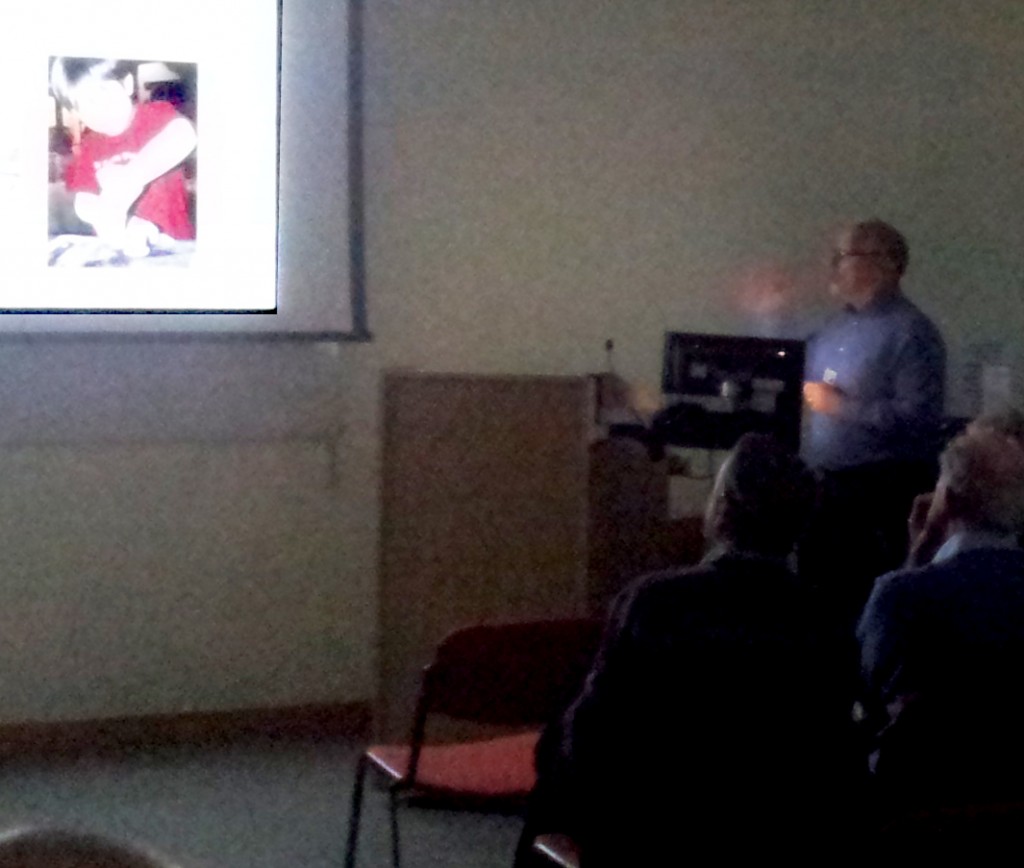 The second aspect of David’s talk explored ideas for Heritage lottery funded projects in the region, based on his extensive experience of successful bids for Heritage Lottery funding for community heritage projects. Giving an overview of the lottery grants that can be used by local groups to promote heritage and examples of successful Young roots and Our Heritage grants, David spoke in detail about the community archaeology projects that these grants funded. Hand-outs prepared by David on the grants available, as well as examples of successful bids for guidance on what could be included in a grant application were included in the conference packs given out to people attending. The last presentation looked forward to integrating participation and enjoyment of Thanet’s Heritage as long term goal for the Isle’s ‘peoplescape’. A challenge was set to the heritage community of the region, to replicate projects with the scope and scale of some of the examples that were shown in David’s presentation.
The second aspect of David’s talk explored ideas for Heritage lottery funded projects in the region, based on his extensive experience of successful bids for Heritage Lottery funding for community heritage projects. Giving an overview of the lottery grants that can be used by local groups to promote heritage and examples of successful Young roots and Our Heritage grants, David spoke in detail about the community archaeology projects that these grants funded. Hand-outs prepared by David on the grants available, as well as examples of successful bids for guidance on what could be included in a grant application were included in the conference packs given out to people attending. The last presentation looked forward to integrating participation and enjoyment of Thanet’s Heritage as long term goal for the Isle’s ‘peoplescape’. A challenge was set to the heritage community of the region, to replicate projects with the scope and scale of some of the examples that were shown in David’s presentation.
The day ended at 4.00pm with a message of thanks to the attendees and speakers from the Chairman and Gerald Moody, Deputy Director of the Trust.
We would like to thank everyone who has been involved with the Trust for Thanet Archaeology over the last 25 years and we hope to see many of you at other events in the future.

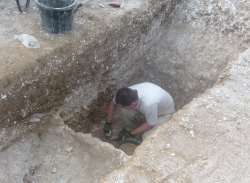
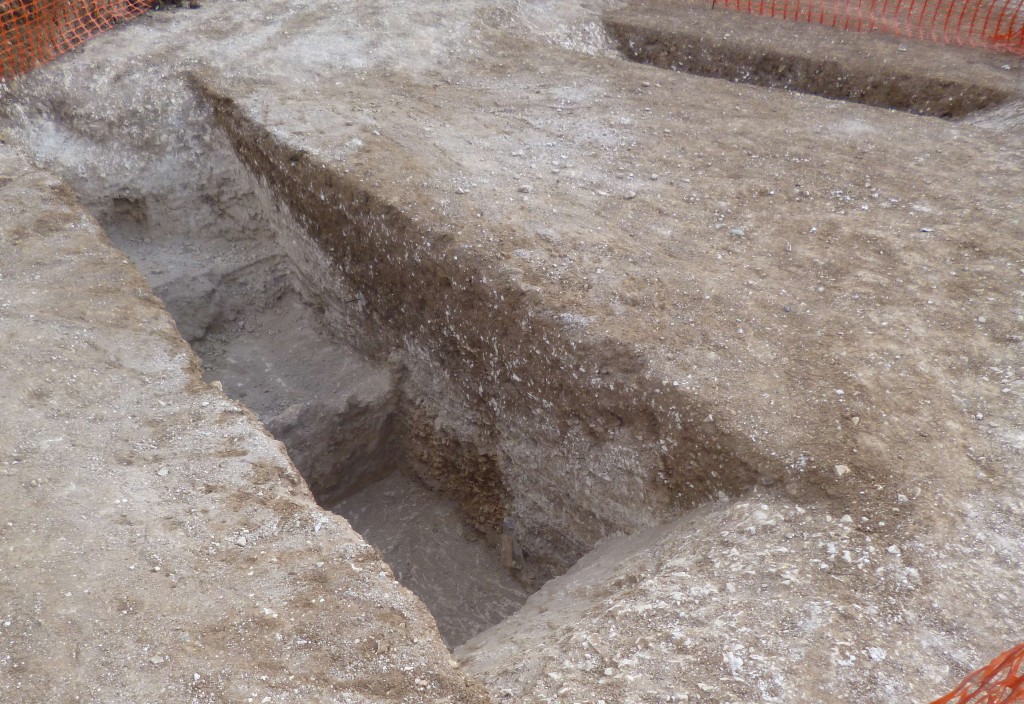
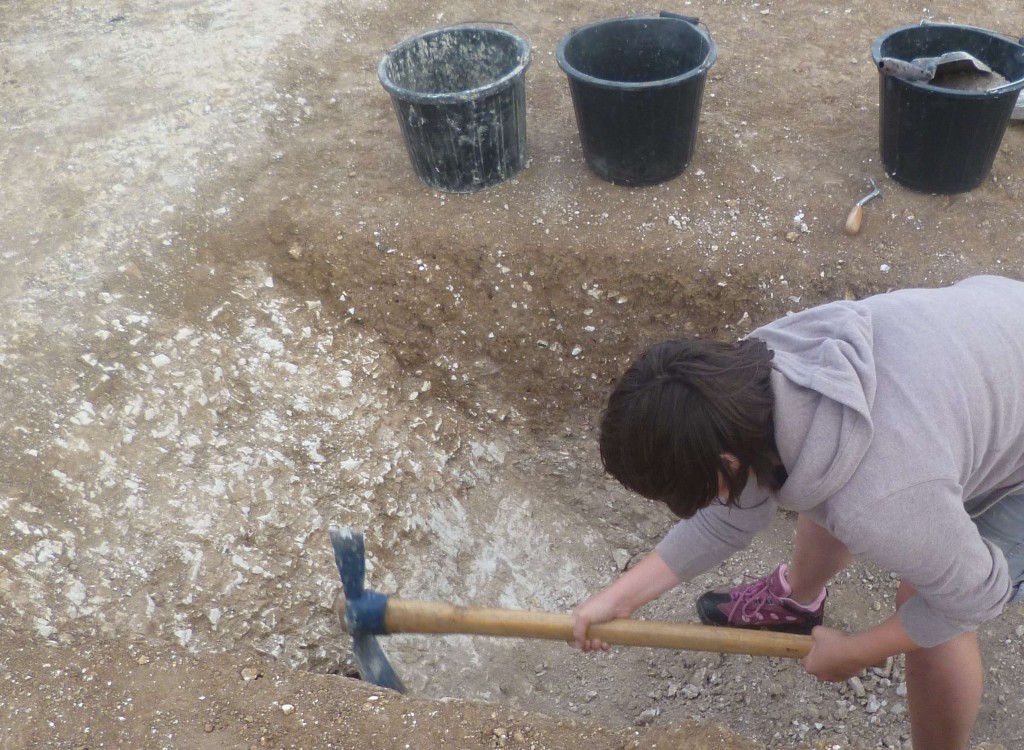
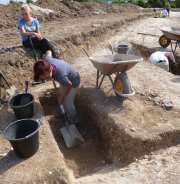
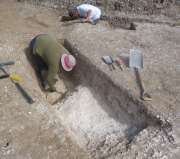
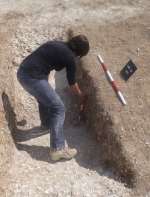
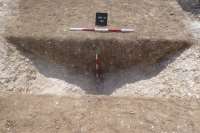

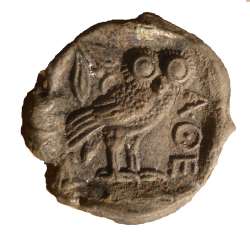
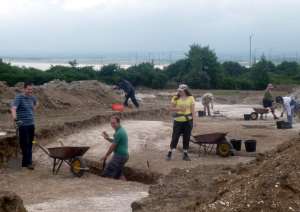
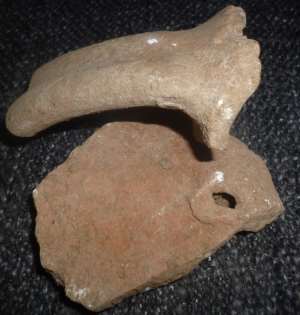
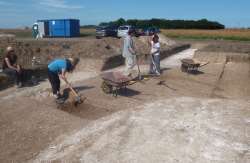
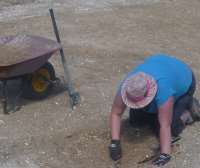 In a later period, as yet undetermined, the southern edge of the round barrow was cut by a series of pits and possibly a large cut feature. We bagan to try to define the dimensions and shape of the feature by excavating another small section into it, As we make progress with this the nature of the later features will be more clearly defined and perhaps dated in the next few days of work at the site.
In a later period, as yet undetermined, the southern edge of the round barrow was cut by a series of pits and possibly a large cut feature. We bagan to try to define the dimensions and shape of the feature by excavating another small section into it, As we make progress with this the nature of the later features will be more clearly defined and perhaps dated in the next few days of work at the site.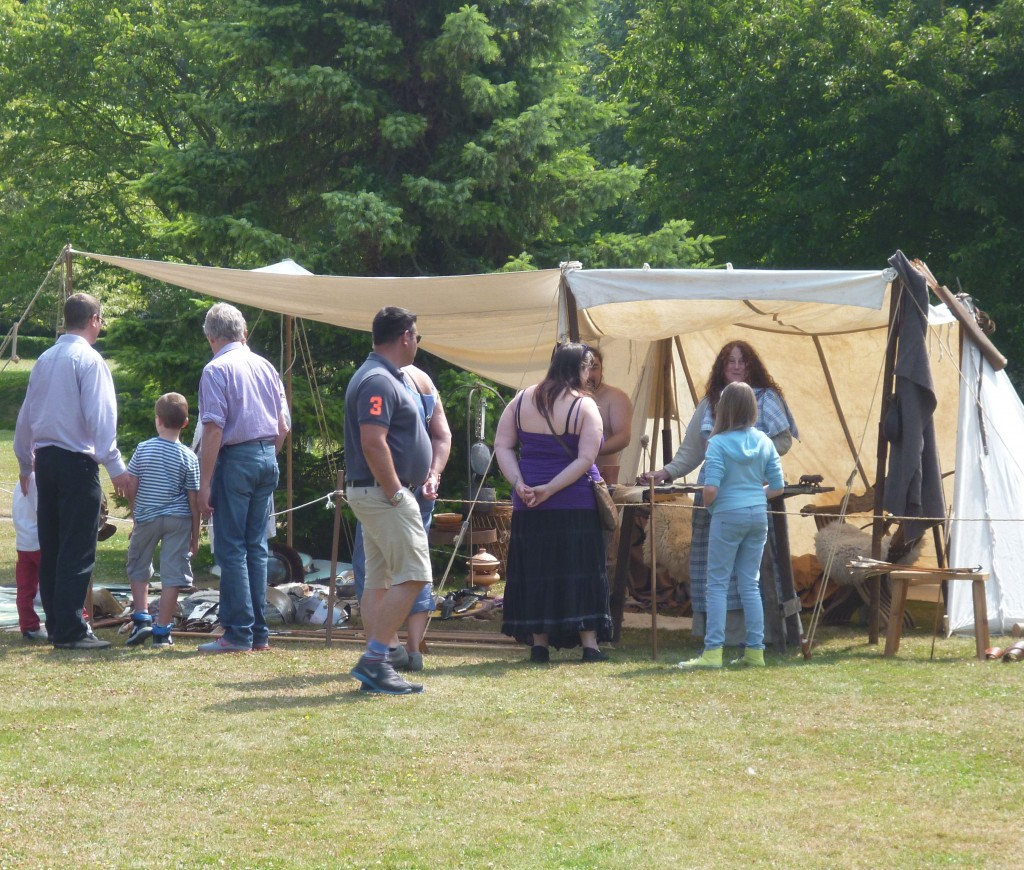
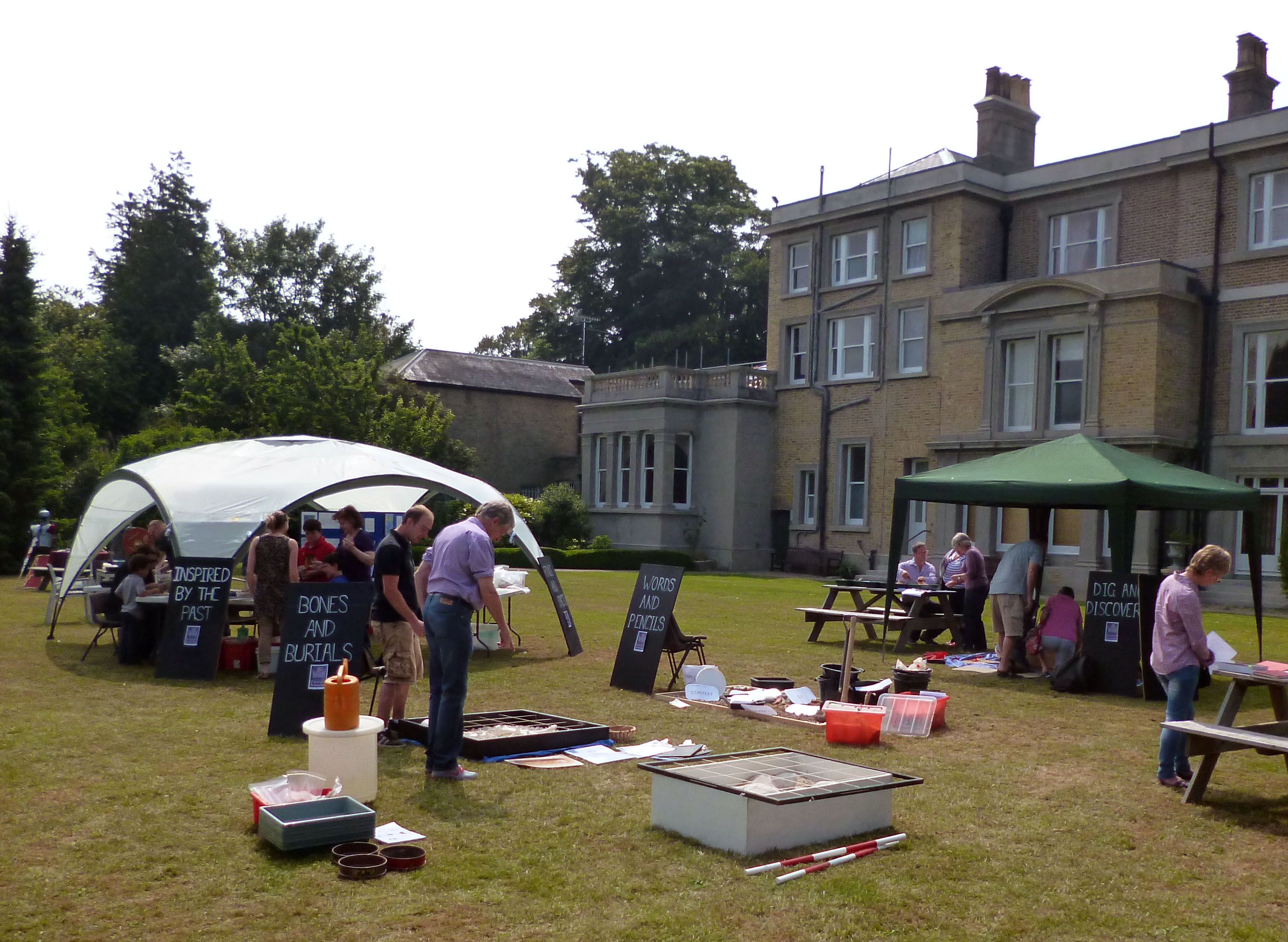
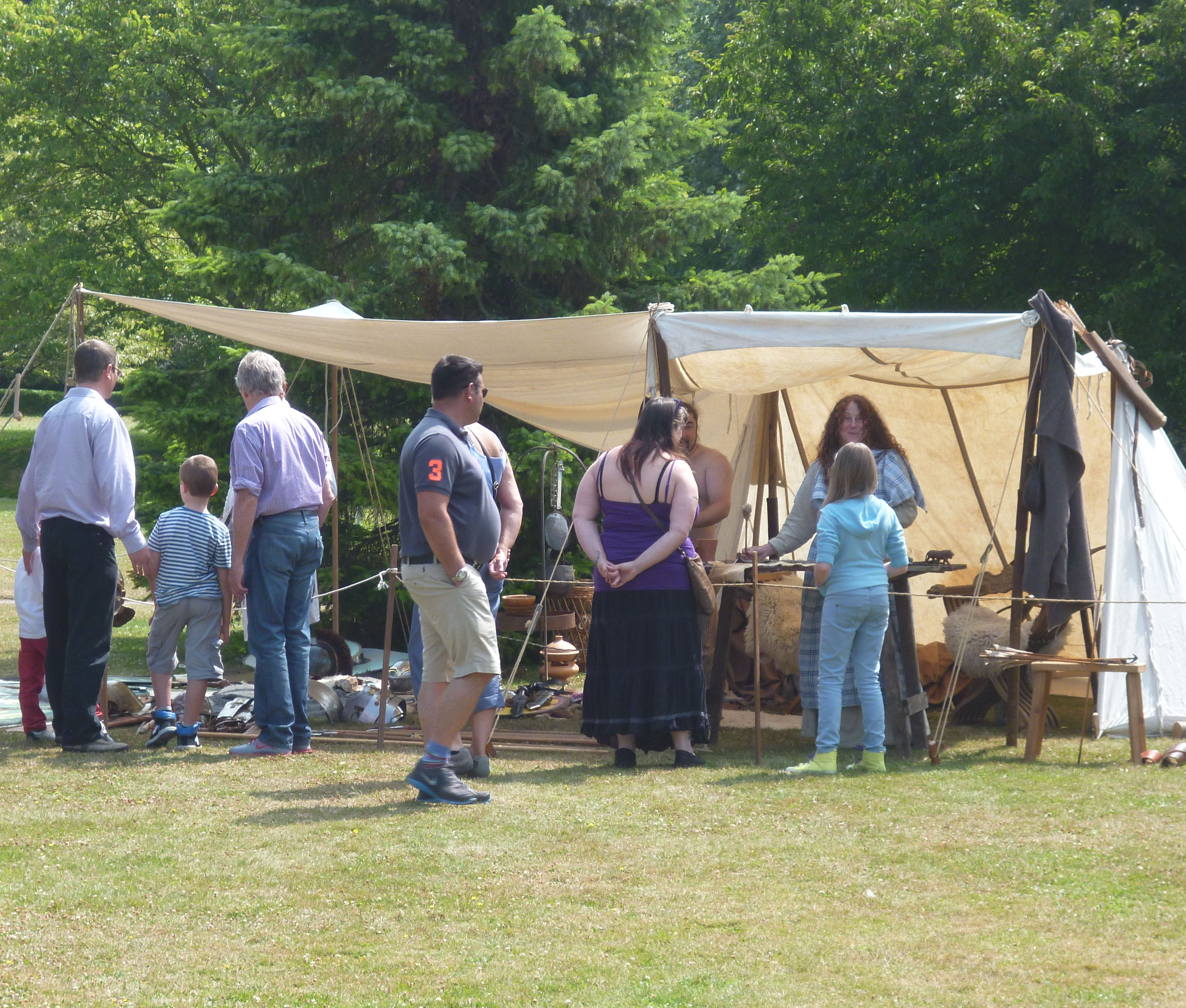
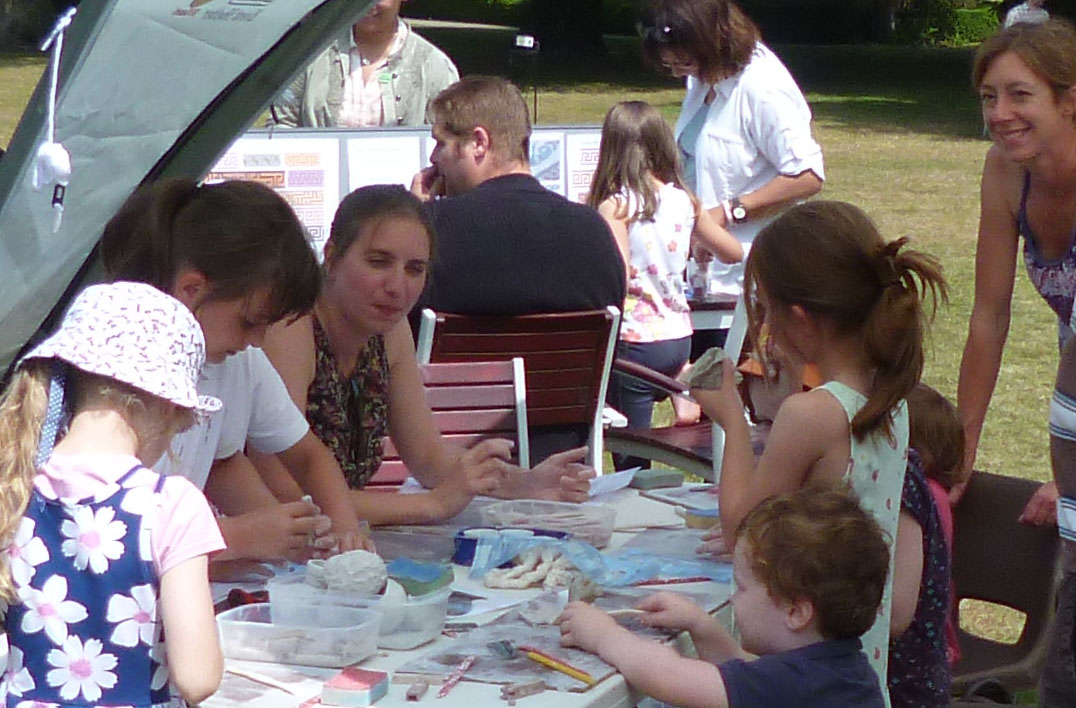
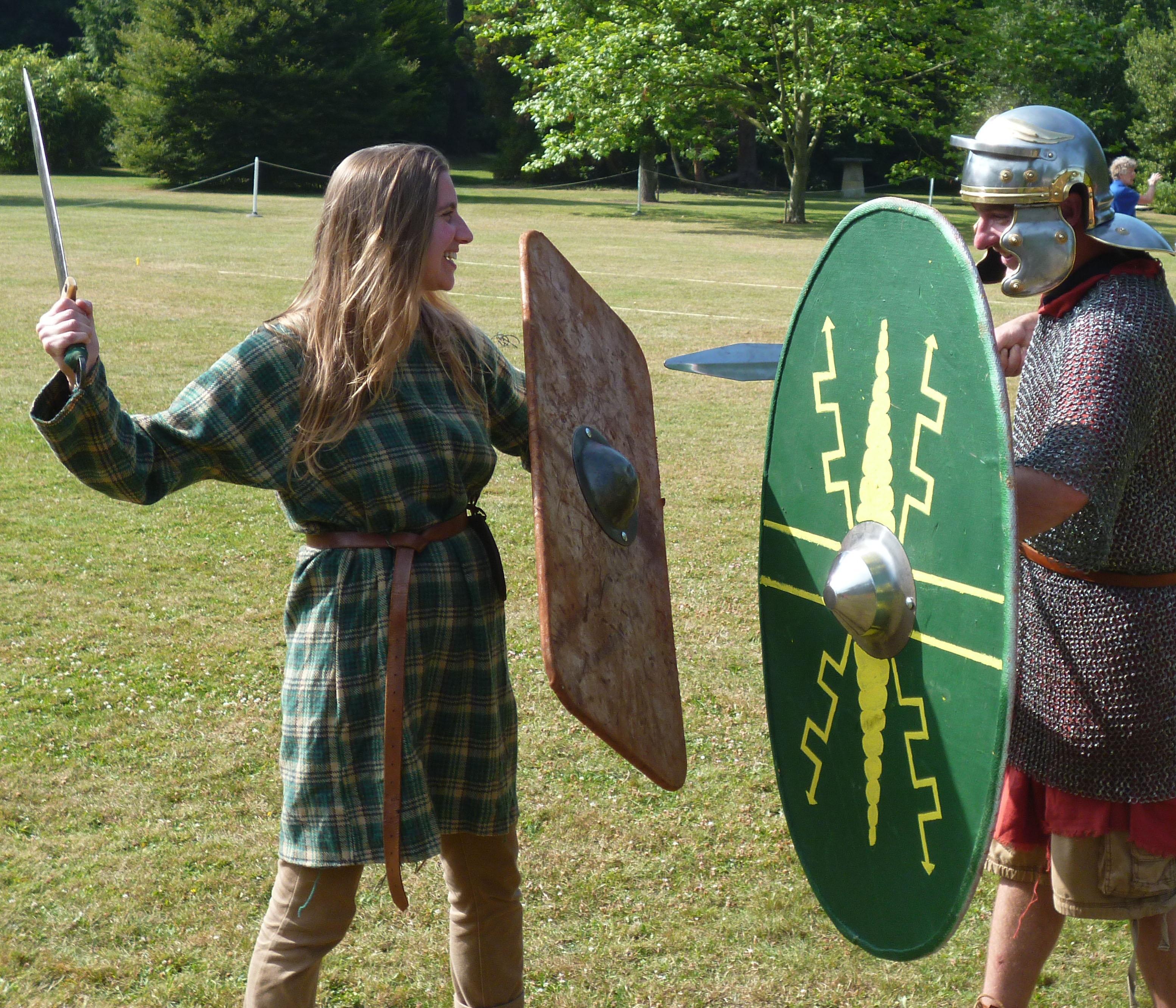
 Iron Age and Roman reenactors De Bello Canzio will be with us over the day at Archaeology for You. With authentic costumes, armour and artefacts this will a be a fascinating glimpse into the past.
Iron Age and Roman reenactors De Bello Canzio will be with us over the day at Archaeology for You. With authentic costumes, armour and artefacts this will a be a fascinating glimpse into the past. Celebrations for the Trusts 25th Anniversary continued on Saturday 27th of April 2013 with a day conference titled Exploring our Past – Preserving our Heritage, also held at the Broadstairs campus of Canterbury Christchurch University.
Celebrations for the Trusts 25th Anniversary continued on Saturday 27th of April 2013 with a day conference titled Exploring our Past – Preserving our Heritage, also held at the Broadstairs campus of Canterbury Christchurch University. Once the congregation of archaeological and heritage minded people attending the conference finished their welcoming teas and coffees at the Touchdown Bar, they swiftly moved to the large lecture theatre for the start of the conference at 9.45 am. The Chairman of the Trust for Thanet Archaeology, Simon Perry, gave a welcoming speech and introduced the first talk, given by Rod LeGear.
Once the congregation of archaeological and heritage minded people attending the conference finished their welcoming teas and coffees at the Touchdown Bar, they swiftly moved to the large lecture theatre for the start of the conference at 9.45 am. The Chairman of the Trust for Thanet Archaeology, Simon Perry, gave a welcoming speech and introduced the first talk, given by Rod LeGear. Rod, a retired mining engineer and a founding member of the Kent Underground Research Group, explained how Thanet’s chalk geology has been exploited in the past by local industry and agriculture. Raw chalk, taken from underground sources ranging from shallow pits to more extensive mines where thousands of tons were produced, was used as a fertiliser and burnt to produce lime for agriculture and to make bricks for the thriving building industry which created Thanet’s sea side suburbs. Many of these pits and mines have been put to other uses and remain visible in Thanet’s landscape with careful observation and historical research. Rod’s presentation drew attention to these industries as valid parts of our heritage and records of lives and labour of many people.
Rod, a retired mining engineer and a founding member of the Kent Underground Research Group, explained how Thanet’s chalk geology has been exploited in the past by local industry and agriculture. Raw chalk, taken from underground sources ranging from shallow pits to more extensive mines where thousands of tons were produced, was used as a fertiliser and burnt to produce lime for agriculture and to make bricks for the thriving building industry which created Thanet’s sea side suburbs. Many of these pits and mines have been put to other uses and remain visible in Thanet’s landscape with careful observation and historical research. Rod’s presentation drew attention to these industries as valid parts of our heritage and records of lives and labour of many people. Dr. Mark Samuel, an architectural archaeologist based in Ramsgate, followed Rod with a talk on a survey that explored the remains of defensive structures that were built to protect the Pegwell Bay area under the threat of German invasion during the early years of the Second World War. Images were shown of the remains of many of the defences that can still be seen in the landscape today with careful observation and a relatively modest amount of field work. Mark explained how the defences were expected to be used in the event of a German invasion and presented some of his ideas about how the importance of the south coast of Thanet and Pegwell Bay might have been perceived during the Second World War, perhaps explaining why many of the sites he surveyed had been lost to history until his survey and research uncovered this secret landscape.
Dr. Mark Samuel, an architectural archaeologist based in Ramsgate, followed Rod with a talk on a survey that explored the remains of defensive structures that were built to protect the Pegwell Bay area under the threat of German invasion during the early years of the Second World War. Images were shown of the remains of many of the defences that can still be seen in the landscape today with careful observation and a relatively modest amount of field work. Mark explained how the defences were expected to be used in the event of a German invasion and presented some of his ideas about how the importance of the south coast of Thanet and Pegwell Bay might have been perceived during the Second World War, perhaps explaining why many of the sites he surveyed had been lost to history until his survey and research uncovered this secret landscape. Emma gave a presentation on the history and importance of Margate Pier, beginning by discussing how the research for the talk was produced for a survey of the pier carried out by the Trust in 2005, in the planning stages for the original design of the Turner Contemporary. A history of the pier was given, beginning with its construction in 1810 and Emma explained how the pier has had a variety of uses for leisure and industry since its construction. Many people were intrigued by the miniature railway which once ran along the harbour wall, prompting much discussion after the talk and later in the lunch break. Emma finished by mentioning some of the changes that have occurred to the fabric of the pier that have left visible traces connected to the development of the town, making the pier a key element of Margate’s historic townscape which records the changing emphasis of the lives and industries that have made Margate thrive in the past.
Emma gave a presentation on the history and importance of Margate Pier, beginning by discussing how the research for the talk was produced for a survey of the pier carried out by the Trust in 2005, in the planning stages for the original design of the Turner Contemporary. A history of the pier was given, beginning with its construction in 1810 and Emma explained how the pier has had a variety of uses for leisure and industry since its construction. Many people were intrigued by the miniature railway which once ran along the harbour wall, prompting much discussion after the talk and later in the lunch break. Emma finished by mentioning some of the changes that have occurred to the fabric of the pier that have left visible traces connected to the development of the town, making the pier a key element of Margate’s historic townscape which records the changing emphasis of the lives and industries that have made Margate thrive in the past. The final speaker of the morning session was Nick Dermott, Conservation Officer for Thanet District Council, who talked about how, as pioneers of mass entertainment, Thanet’s historic townscapes were shaped by the early growth of the leisure industry. Beginning by looking at the history of pleasure gardens and the remarkable survival of one example at Ranelagh Grove at St Peters, Nick went on to talk about the history of Margate as an archetype of the seaside town where beach holidays originated. Nick spoke about the popularity of sea bathing in Margate and even the contemporary issues surrounding the development of mixed and even naked bathing. Keeping to the beaches, other forms of entertainment were touched on, such as the popular Donkey rides on the beach and Punch and Judy shows. Nick also looked at other forms of entertainment from Margate’s past away from the beach; the theatres, music halls, cinemas, Winter Gardens, West Cliff Hall and the importance to Margate of the development of Dreamland. The presentation was richly illustrated with wonderful and rare photographs, posters and books which reflected the rich diversity of Thanet as a tourist destination in the past present and future.
The final speaker of the morning session was Nick Dermott, Conservation Officer for Thanet District Council, who talked about how, as pioneers of mass entertainment, Thanet’s historic townscapes were shaped by the early growth of the leisure industry. Beginning by looking at the history of pleasure gardens and the remarkable survival of one example at Ranelagh Grove at St Peters, Nick went on to talk about the history of Margate as an archetype of the seaside town where beach holidays originated. Nick spoke about the popularity of sea bathing in Margate and even the contemporary issues surrounding the development of mixed and even naked bathing. Keeping to the beaches, other forms of entertainment were touched on, such as the popular Donkey rides on the beach and Punch and Judy shows. Nick also looked at other forms of entertainment from Margate’s past away from the beach; the theatres, music halls, cinemas, Winter Gardens, West Cliff Hall and the importance to Margate of the development of Dreamland. The presentation was richly illustrated with wonderful and rare photographs, posters and books which reflected the rich diversity of Thanet as a tourist destination in the past present and future. The first presentation in the afternoon session after lunch, was given by Bob Pantony, a long standing member of the Isle of Thanet Archaeological Society. Ably assisted in his slide show by Mr. Bob Varnham, Bob Pantony spoke of the contribution of Doctor Arthur Rowe of Margate, and his father before him, to the study of the Geology and Archaeology of Thanet in the early 20th century. Dr. Rowe’s private archaeological collection was bequeathed to the people of Margate and included finds from his own excavations as well as discoveries made during the expansion of Thanet’s towns, along with material his father, Dr. Thomas Smith Rowe, had collected. The senior Dr. Rowe was firmly established as an early archaeologist in Thanet who contributed a great deal to the collection that his son left to the people of Margate and Bob had even traced an interesting line drawn portrait of him from a local newspaper. Images were shown of many of the items that were formerly in the collection, some of which are now held by the British Museum. Attention was drawn to the poor state of preservation of much of the Rowe bequest material in other collections which has not been properly conserved. It was evident from Bob’s efforts to trace the items from the Rowe Bequest that Arthur Rowe was a pioneer of intellectual enquiry into Thanet’s past, an important element of Thanet’s historic ‘peoplescape’.
The first presentation in the afternoon session after lunch, was given by Bob Pantony, a long standing member of the Isle of Thanet Archaeological Society. Ably assisted in his slide show by Mr. Bob Varnham, Bob Pantony spoke of the contribution of Doctor Arthur Rowe of Margate, and his father before him, to the study of the Geology and Archaeology of Thanet in the early 20th century. Dr. Rowe’s private archaeological collection was bequeathed to the people of Margate and included finds from his own excavations as well as discoveries made during the expansion of Thanet’s towns, along with material his father, Dr. Thomas Smith Rowe, had collected. The senior Dr. Rowe was firmly established as an early archaeologist in Thanet who contributed a great deal to the collection that his son left to the people of Margate and Bob had even traced an interesting line drawn portrait of him from a local newspaper. Images were shown of many of the items that were formerly in the collection, some of which are now held by the British Museum. Attention was drawn to the poor state of preservation of much of the Rowe bequest material in other collections which has not been properly conserved. It was evident from Bob’s efforts to trace the items from the Rowe Bequest that Arthur Rowe was a pioneer of intellectual enquiry into Thanet’s past, an important element of Thanet’s historic ‘peoplescape’. The second aspect of David’s talk explored ideas for Heritage lottery funded projects in the region, based on his extensive experience of successful bids for Heritage Lottery funding for community heritage projects. Giving an overview of the lottery grants that can be used by local groups to promote heritage and examples of successful Young roots and Our Heritage grants, David spoke in detail about the community archaeology projects that these grants funded. Hand-outs prepared by David on the grants available, as well as examples of successful bids for guidance on what could be included in a grant application were included in the conference packs given out to people attending. The last presentation looked forward to integrating participation and enjoyment of Thanet’s Heritage as long term goal for the Isle’s ‘peoplescape’. A challenge was set to the heritage community of the region, to replicate projects with the scope and scale of some of the examples that were shown in David’s presentation.
The second aspect of David’s talk explored ideas for Heritage lottery funded projects in the region, based on his extensive experience of successful bids for Heritage Lottery funding for community heritage projects. Giving an overview of the lottery grants that can be used by local groups to promote heritage and examples of successful Young roots and Our Heritage grants, David spoke in detail about the community archaeology projects that these grants funded. Hand-outs prepared by David on the grants available, as well as examples of successful bids for guidance on what could be included in a grant application were included in the conference packs given out to people attending. The last presentation looked forward to integrating participation and enjoyment of Thanet’s Heritage as long term goal for the Isle’s ‘peoplescape’. A challenge was set to the heritage community of the region, to replicate projects with the scope and scale of some of the examples that were shown in David’s presentation.